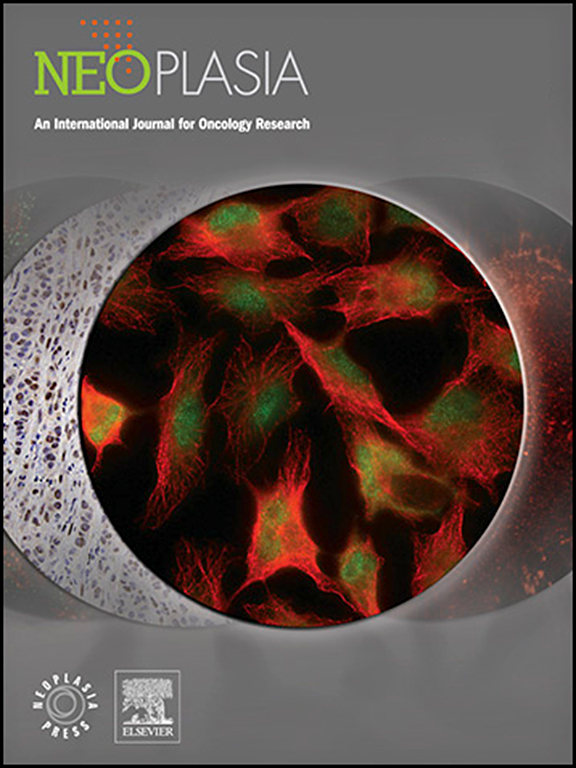睾丸切除术诱导雄激素剥夺介导的小鼠前列腺细胞组成和基因表达调节的时空图谱
IF 7.7
2区 医学
Q1 Biochemistry, Genetics and Molecular Biology
引用次数: 0
摘要
雄激素剥夺疗法(ADT)仍然是前列腺癌(PCa)治疗的基石,但大多数肿瘤最终会产生耐药性。小鼠模型被广泛用于研究前列腺癌的进展和ADT反应,但缺乏对这些模型中前列腺对雄激素剥夺的生物学反应的详细了解。在这里,我们展示了睾丸切除术(ORX)诱导雄激素剥夺后小鼠前列腺细胞和转录动力学的时空分析,重点关注非上皮成分。我们观察到所有前列腺叶(背侧、腹侧、外侧和前部)的渐进式退化,以及orx后不同的叶特异性颞基因表达变化。随着时间的推移,免疫细胞浸润明显增加,突显了前列腺细胞景观的变化。单细胞RNA测序揭示了一种先前未被描述的成纤维细胞亚型,称为orx诱导成纤维细胞(OIF),其特征是Wnt2、Rorb和Wif1的高表达,具有明显的空间定位。途径分析显示酰胺和肽结合功能上调,同时抑制肽酶和内肽酶活性。此外,配体-受体相互作用的动态变化强调了orx后前列腺细胞间通讯的进化。通过将空间转录组学与单细胞分析相结合,我们的研究生成了小鼠前列腺对雄激素剥夺反应的高分辨率图谱。这些发现为解释临床前PCa模型中的ADT反应提供了基础资源。本文章由计算机程序翻译,如有差异,请以英文原文为准。
A spatiotemporal atlas of orchiectomy-induced androgen deprivation-mediated modulation of cellular composition and gene expression in the mouse prostate
Androgen deprivation therapy (ADT) remains a cornerstone in the treatment of prostate cancer (PCa), yet most tumors eventually develop resistance. Murine models are widely used to study PCa progression and ADT response, but a detailed understanding of the prostate’s biological response to androgen deprivation in these models is lacking. Here, we present a spatiotemporal analysis of cellular and transcriptional dynamics in the mouse prostate following orchiectomy (ORX)-induced androgen deprivation with a focus on non-epithelial components. We observed progressive involution across all prostate lobes (dorsal, ventral, lateral, and anterior) and distinct lobe-specific temporal gene expression changes post-ORX. Immune cell infiltration markedly increased over time, highlighting a shift in the prostate’s cellular landscape. Single-cell RNA sequencing uncovered a previously undescribed fibroblast subtype—termed ORX-induced fibroblast (OIF)—characterized by high expression of Wnt2, Rorb, and Wif1, with distinct spatial localization. Pathway analysis revealed upregulation of amide and peptide binding functions, alongside suppression of peptidase and endopeptidase activity. Furthermore, dynamic changes in ligand–receptor interactions across lobes underscored the evolving intercellular communication in the post-ORX prostate. By integrating spatial transcriptomics with single-cell profiling, our study generates a high-resolution atlas of the murine prostate’s response to androgen deprivation. These findings provide a foundational resource for interpreting ADT responses in preclinical models of PCa.
求助全文
通过发布文献求助,成功后即可免费获取论文全文。
去求助
来源期刊

Neoplasia
医学-肿瘤学
CiteScore
9.20
自引率
2.10%
发文量
82
审稿时长
26 days
期刊介绍:
Neoplasia publishes the results of novel investigations in all areas of oncology research. The title Neoplasia was chosen to convey the journal’s breadth, which encompasses the traditional disciplines of cancer research as well as emerging fields and interdisciplinary investigations. Neoplasia is interested in studies describing new molecular and genetic findings relating to the neoplastic phenotype and in laboratory and clinical studies demonstrating creative applications of advances in the basic sciences to risk assessment, prognostic indications, detection, diagnosis, and treatment. In addition to regular Research Reports, Neoplasia also publishes Reviews and Meeting Reports. Neoplasia is committed to ensuring a thorough, fair, and rapid review and publication schedule to further its mission of serving both the scientific and clinical communities by disseminating important data and ideas in cancer research.
 求助内容:
求助内容: 应助结果提醒方式:
应助结果提醒方式:


